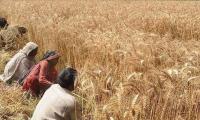KARACHI: Cotton prices in Pakistan soared to their highest level of the season this week, as textile mills scrambled to secure quality supplies amid a domestic shortage and rising global rates, industry officials said on Saturday.
The spot rate for cotton jumped to Rs19,700 per maund (40 kg), up 27 percent from Rs15,500 a month ago, according to the Karachi Cotton Association (KCA).
As of December 23, cotton prices in Sindh ranged from Rs15,500 to Rs17,800 per maund, while in Punjab, they ranged from Rs16,500 to Rs17,000 per maund, marking an increase of approximately Rs4,000 per maund.
Presently, cotton prices stand at Rs18,500 to Rs21,000 per maund in Sindh and Rs19,000 to Rs21,000 per maund in Punjab, with spot rates reaching Rs19,700 per maund.
The surge in cotton prices can also be attributed to a reduction in the supply of quality cotton in the local market, particularly due to large textile groups stocking up on quality cotton.
Previously, when the price of New York cotton futures ranged between 79 and 81 cents per pound, major groups were importing cotton profitably. However, with New York cotton futures climbing to approximately 86.50 to 87 cents, import deals became less lucrative, leading to a rapid increase in local cotton prices.
The acquisition spree by textile mills, especially in the past week and with the onset of the new year, has led to a significant rise in cotton prices, reaching up to Rs3,000 to Rs4,000 per maund.
Naseem Usman, chairman of the Karachi Cotton Brokers Association, said expectations are high for increased cotton sowing in the lower regions of Sindh, particularly in anticipation of higher yields, while early farming of cotton is also underway in various regions of Punjab, further contributing to the optimistic outlook for cotton production. It is estimated that cotton production in the country this season will reach approximately 8.4 million bales, with textile mills requiring around 13 million bales, indicating a shortfall that may necessitate imports.
Last year, nearly 1.5 million bales were imported to fulfil contractual obligations, with an additional 800,000 bales expected from Afghanistan. The reopening of the Afghan border after a 10-day closure and the potential reopening of the Chaman border offer hope for increased imports. In a recent meeting, the American Consul General in Lahore engaged in discussions with the All Pakistan Textile Mills Association (APTMA) to enhance trade and economic relations between Pakistan and the United States.
With the cotton industry facing concerns over declining domestic production, there is a pressing need to boost cotton cultivation.
In a proactive effort to invigorate the textile industry, the Sindh government has initiated work on the modernization of Karachi's garment city. This industrial estate, dedicated to the production of value-added textile products, spans over 300 acres and marks a significant transformation. This initiative aims to promote industrial units and water treatment plants within the city limits to ensure favourable environmental conditions.
Addressing a seminar in Hyderabad earlier this week, director general of Agriculture Sindh, Munir Ahmed Jumani, highlighted the importance of cotton as the backbone of the country's industrial sector. However, continuous declines in cotton production due to adverse weather conditions, water scarcity, and pest attacks are impacting cotton yields negatively.
Sajid Mahmood, a cotton broker, emphasized the need for technological advancements to double the average cotton yield per acre, from 700 kilograms to 1,500 kilograms. He also shed light on the significant losses incurred due to attacks by pink bollworms, estimating an annual loss of 1.5 to 2 million bales, which equates to a 0.5 percent increase in GDP and an additional billion-dollar burden on the economy.
A disabled man casting his vote in Indian elections on May 1, 2024. — X/@CEOMPElectionsNOIDA: To go back home in...
People attend the 2023 Spring Meetings inside the International Monetary Fund in Washington, US, April 12, 2023. —...
A representational image showing a Tesla Model Y during the opening of the Tesla Gigafactory in Gruenheide, east of...
Established in 1998, IceWarp has presence in more than 100 countries and provides specialized and highly...
Women walk past a “Now Hiring” sign outside a store on August 16, 2021 in Arlington, Virginia. — AFPWASHINGTON:...
Reko Diq, one of the biggest yet-to-be-developed copper mines in the world, is also 50 percent owned by the government...







